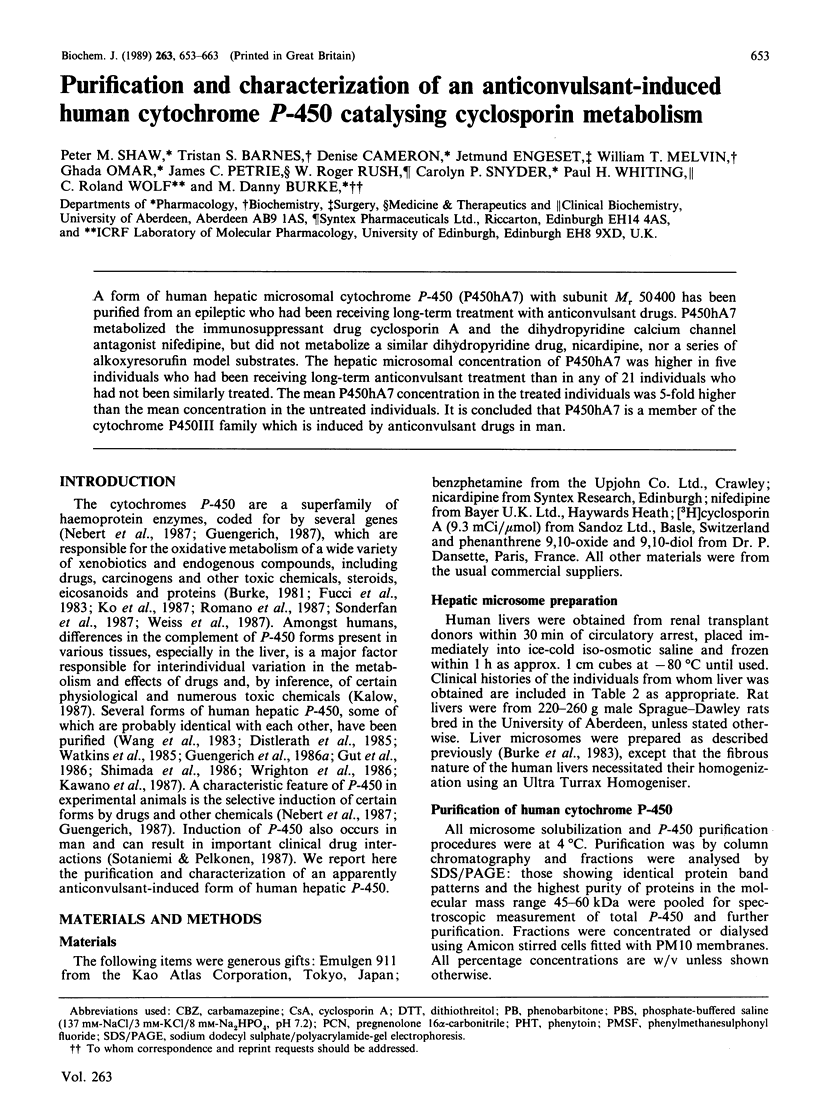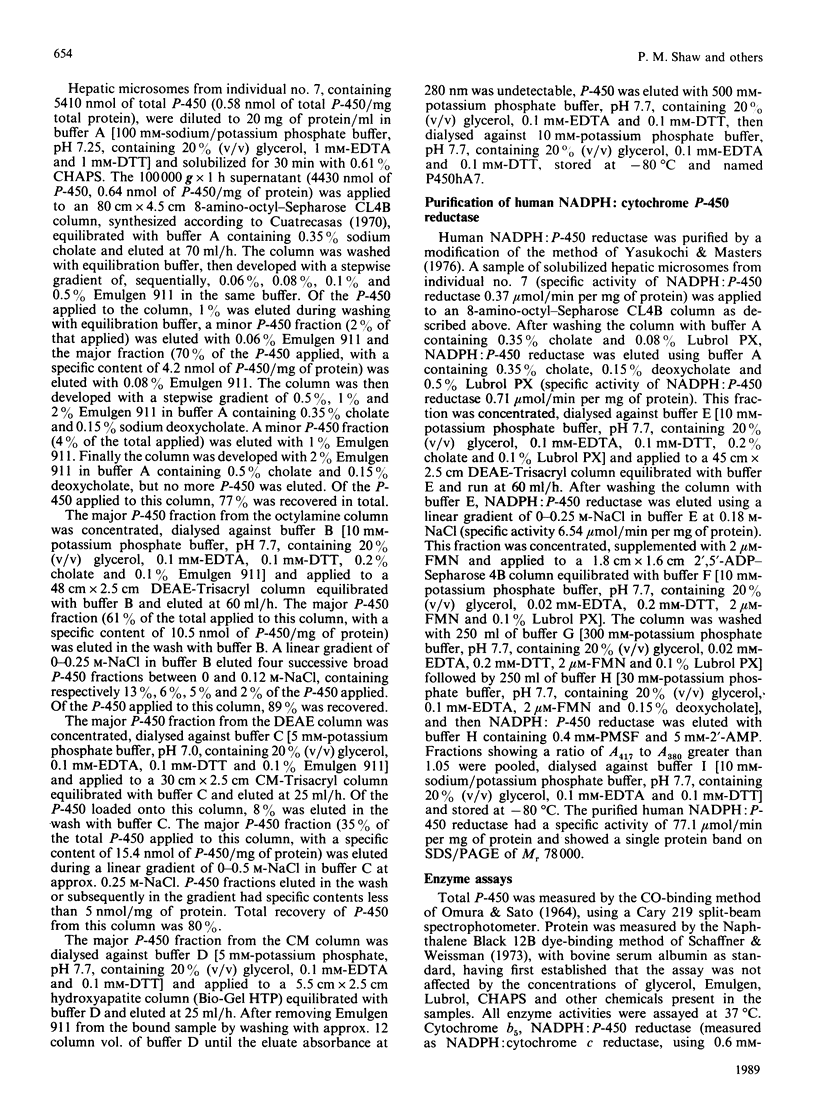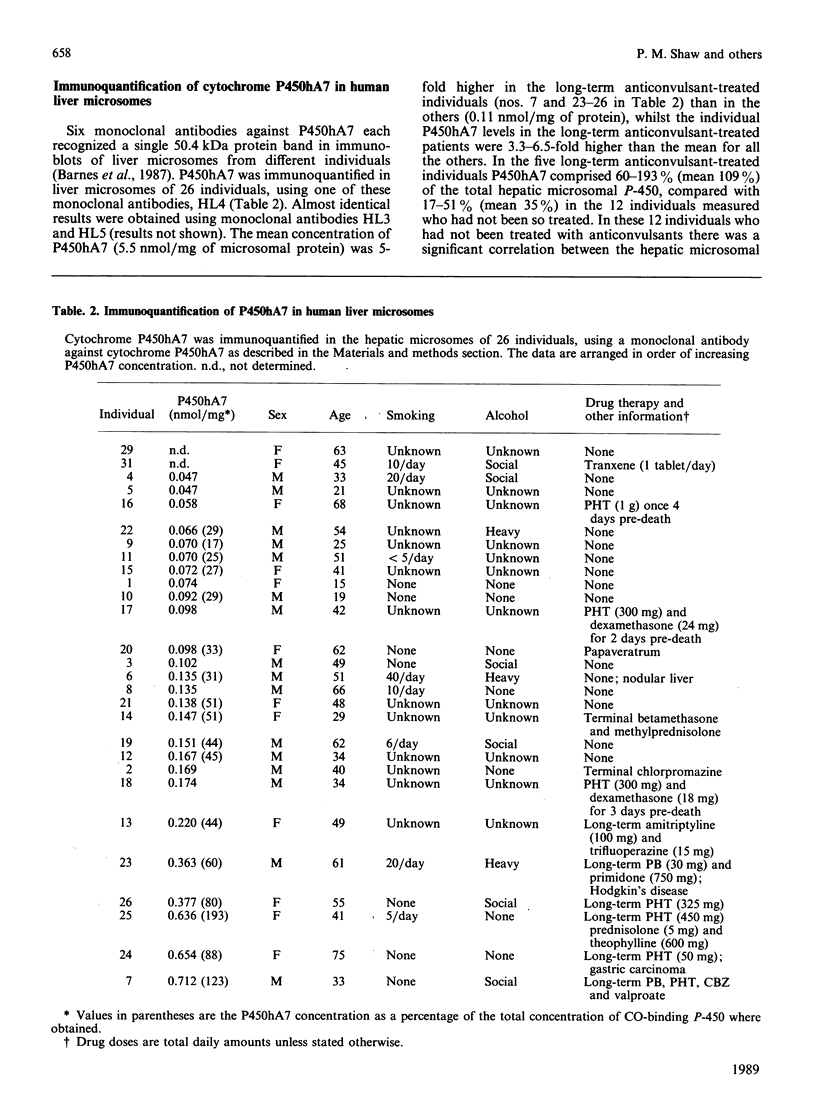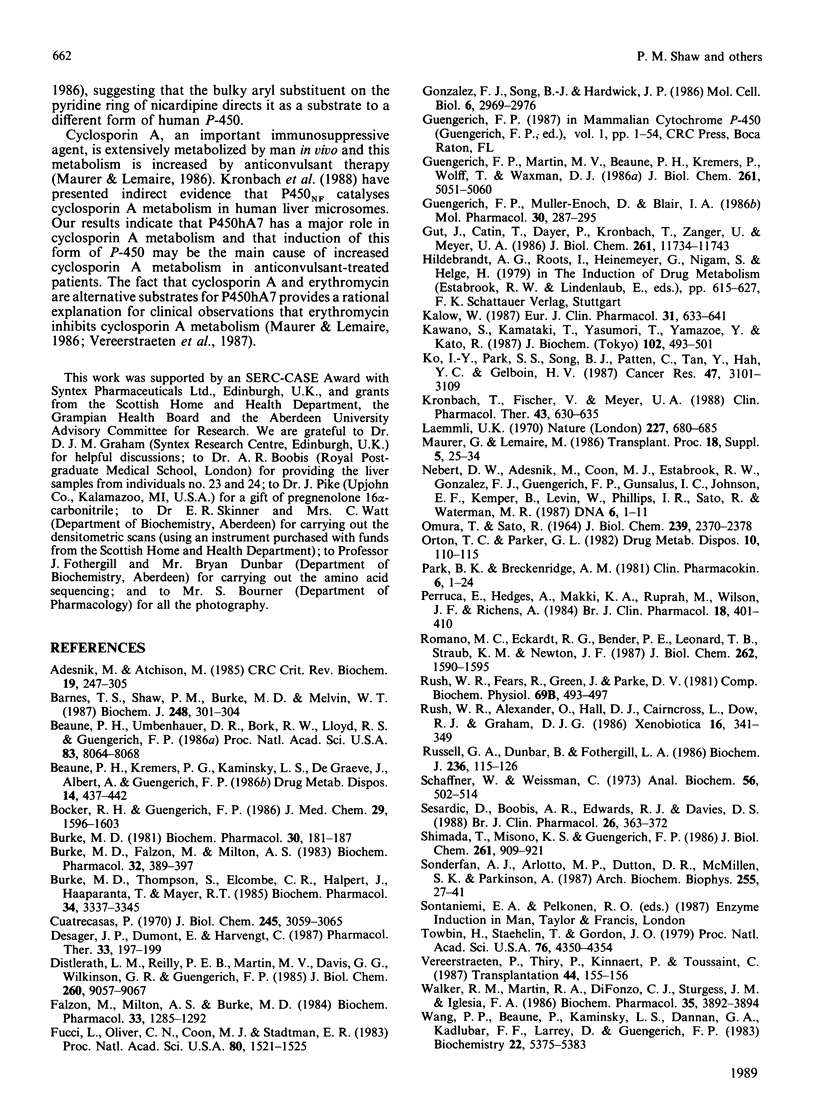Abstract
A form of human hepatic microsomal cytochrome P-450 (P450hA7) with subunit Mr 50,400 has been purified from an epileptic who had been receiving long-term treatment with anticonvulsant drugs. P450hA7 metabolized the immunosuppressant drug cyclosporin A and the dihydropyridine calcium channel antagonist nifedipine, but did not metabolize a similar dihydropyridine drug, nicardipine, nor a series of alkoxyresorufin model substrates. The hepatic microsomal concentration of P450hA7 was higher in five individuals who had been receiving long-term anticonvulsant treatment than in any of 21 individuals who had not been similarly treated. The mean P450hA7 concentration in the treated individuals was 5-fold higher than the mean concentration in the untreated individuals. It is concluded that P450hA7 is a member of the cytochrome P450III family which is induced by anticonvulsant drugs in man.
Full text
PDF










Images in this article
Selected References
These references are in PubMed. This may not be the complete list of references from this article.
- Adesnik M., Atchison M. Genes for cytochrome P-450 and their regulation. CRC Crit Rev Biochem. 1986;19(3):247–305. doi: 10.3109/10409238609084657. [DOI] [PubMed] [Google Scholar]
- Barnes T. S., Shaw P. M., Burke M. D., Melvin W. T. Monoclonal antibodies against human cytochrome P-450 recognizing different pregnenolone 16 alpha-carbonitrile-inducible rat cytochromes P-450. Biochem J. 1987 Nov 15;248(1):301–304. doi: 10.1042/bj2480301. [DOI] [PMC free article] [PubMed] [Google Scholar]
- Beaune P. H., Kremers P. G., Kaminsky L. S., De Graeve J., Albert A., Guengerich F. P. Comparison of monooxygenase activities and cytochrome P-450 isozyme concentrations in human liver microsomes. Drug Metab Dispos. 1986 Jul-Aug;14(4):437–442. [PubMed] [Google Scholar]
- Beaune P. H., Umbenhauer D. R., Bork R. W., Lloyd R. S., Guengerich F. P. Isolation and sequence determination of a cDNA clone related to human cytochrome P-450 nifedipine oxidase. Proc Natl Acad Sci U S A. 1986 Nov;83(21):8064–8068. doi: 10.1073/pnas.83.21.8064. [DOI] [PMC free article] [PubMed] [Google Scholar]
- Burke M. D. Cytochrome P-450: a pharmacological necessity or a biochemical curiosity? Biochem Pharmacol. 1981 Feb 1;30(3):181–187. doi: 10.1016/0006-2952(81)90076-9. [DOI] [PubMed] [Google Scholar]
- Burke M. D., Falzon M., Milton A. S. Decreased hepatic microsomal cytochrome P450 due to indomethacin: protective roles of 16,16-dimethylprostaglandin F2 alpha and inducing agents. Biochem Pharmacol. 1983 Feb 1;32(3):389–397. doi: 10.1016/0006-2952(83)90516-6. [DOI] [PubMed] [Google Scholar]
- Burke M. D., Thompson S., Elcombe C. R., Halpert J., Haaparanta T., Mayer R. T. Ethoxy-, pentoxy- and benzyloxyphenoxazones and homologues: a series of substrates to distinguish between different induced cytochromes P-450. Biochem Pharmacol. 1985 Sep 15;34(18):3337–3345. doi: 10.1016/0006-2952(85)90355-7. [DOI] [PubMed] [Google Scholar]
- Böcker R. H., Guengerich F. P. Oxidation of 4-aryl- and 4-alkyl-substituted 2,6-dimethyl-3,5-bis(alkoxycarbonyl)-1,4-dihydropyridines by human liver microsomes and immunochemical evidence for the involvement of a form of cytochrome P-450. J Med Chem. 1986 Sep;29(9):1596–1603. doi: 10.1021/jm00159a007. [DOI] [PubMed] [Google Scholar]
- Cuatrecasas P. Protein purification by affinity chromatography. Derivatizations of agarose and polyacrylamide beads. J Biol Chem. 1970 Jun;245(12):3059–3065. [PubMed] [Google Scholar]
- Desager J. P., Dumont E., Harvengt C. The urinary 6 beta-hydroxycortisol excretion in man on inducers and inhibitors of the hepatic mixed function oxidase. Pharmacol Ther. 1987;33(1):197–199. doi: 10.1016/0163-7258(87)90051-9. [DOI] [PubMed] [Google Scholar]
- Distlerath L. M., Reilly P. E., Martin M. V., Davis G. G., Wilkinson G. R., Guengerich F. P. Purification and characterization of the human liver cytochromes P-450 involved in debrisoquine 4-hydroxylation and phenacetin O-deethylation, two prototypes for genetic polymorphism in oxidative drug metabolism. J Biol Chem. 1985 Jul 25;260(15):9057–9067. [PubMed] [Google Scholar]
- Falzon M., Milton A. S., Burke M. D. Are the decreases in hepatic cytochrome P-450 and other drug-metabolising enzymes caused by indomethacin in vivo mediated by intestinal bacterial endotoxins? 16,16-Dimethylprostaglandin F2 alpha prevents decreases in hepatic drug-metabolising enzymes due to exogenous endotoxin. Biochem Pharmacol. 1984 Apr 15;33(8):1285–1292. doi: 10.1016/0006-2952(84)90182-5. [DOI] [PubMed] [Google Scholar]
- Fucci L., Oliver C. N., Coon M. J., Stadtman E. R. Inactivation of key metabolic enzymes by mixed-function oxidation reactions: possible implication in protein turnover and ageing. Proc Natl Acad Sci U S A. 1983 Mar;80(6):1521–1525. doi: 10.1073/pnas.80.6.1521. [DOI] [PMC free article] [PubMed] [Google Scholar]
- Gonzalez F. J., Song B. J., Hardwick J. P. Pregnenolone 16 alpha-carbonitrile-inducible P-450 gene family: gene conversion and differential regulation. Mol Cell Biol. 1986 Aug;6(8):2969–2976. doi: 10.1128/mcb.6.8.2969. [DOI] [PMC free article] [PubMed] [Google Scholar]
- Guengerich F. P., Martin M. V., Beaune P. H., Kremers P., Wolff T., Waxman D. J. Characterization of rat and human liver microsomal cytochrome P-450 forms involved in nifedipine oxidation, a prototype for genetic polymorphism in oxidative drug metabolism. J Biol Chem. 1986 Apr 15;261(11):5051–5060. [PubMed] [Google Scholar]
- Guengerich F. P., Müller-Enoch D., Blair I. A. Oxidation of quinidine by human liver cytochrome P-450. Mol Pharmacol. 1986 Sep;30(3):287–295. [PubMed] [Google Scholar]
- Gut J., Catin T., Dayer P., Kronbach T., Zanger U., Meyer U. A. Debrisoquine/sparteine-type polymorphism of drug oxidation. Purification and characterization of two functionally different human liver cytochrome P-450 isozymes involved in impaired hydroxylation of the prototype substrate bufuralol. J Biol Chem. 1986 Sep 5;261(25):11734–11743. [PubMed] [Google Scholar]
- Kalow W. Genetic variation in the human hepatic cytochrome P-450 system. Eur J Clin Pharmacol. 1987;31(6):633–641. doi: 10.1007/BF00541288. [DOI] [PubMed] [Google Scholar]
- Kawano S., Kamataki T., Yasumori T., Yamazoe Y., Kato R. Purification of human liver cytochrome P-450 catalyzing testosterone 6 beta-hydroxylation. J Biochem. 1987 Sep;102(3):493–501. doi: 10.1093/oxfordjournals.jbchem.a122081. [DOI] [PubMed] [Google Scholar]
- Ko I. Y., Park S. S., Song B. J., Patten C., Tan Y. Z., Hah Y. C., Yang C. S., Gelboin H. V. Monoclonal antibodies to ethanol-induced rat liver cytochrome P-450 that metabolizes aniline and nitrosamines. Cancer Res. 1987 Jun 15;47(12):3101–3109. [PubMed] [Google Scholar]
- Kronbach T., Fischer V., Meyer U. A. Cyclosporine metabolism in human liver: identification of a cytochrome P-450III gene family as the major cyclosporine-metabolizing enzyme explains interactions of cyclosporine with other drugs. Clin Pharmacol Ther. 1988 Jun;43(6):630–635. doi: 10.1038/clpt.1988.87. [DOI] [PubMed] [Google Scholar]
- Laemmli U. K. Cleavage of structural proteins during the assembly of the head of bacteriophage T4. Nature. 1970 Aug 15;227(5259):680–685. doi: 10.1038/227680a0. [DOI] [PubMed] [Google Scholar]
- Nebert D. W., Adesnik M., Coon M. J., Estabrook R. W., Gonzalez F. J., Guengerich F. P., Gunsalus I. C., Johnson E. F., Kemper B., Levin W. The P450 gene superfamily: recommended nomenclature. DNA. 1987 Feb;6(1):1–11. doi: 10.1089/dna.1987.6.1. [DOI] [PubMed] [Google Scholar]
- OMURA T., SATO R. THE CARBON MONOXIDE-BINDING PIGMENT OF LIVER MICROSOMES. I. EVIDENCE FOR ITS HEMOPROTEIN NATURE. J Biol Chem. 1964 Jul;239:2370–2378. [PubMed] [Google Scholar]
- Orton T. C., Parker G. L. The effect of hypolipidemic agents on the hepatic microsomal drug-metabolizing enzyme system of the rat. Induction of cytochrome(s) P-450 with specificity toward terminal hydroxylation of lauric acid. Drug Metab Dispos. 1982 Mar-Apr;10(2):110–115. [PubMed] [Google Scholar]
- Park B. K., Breckenridge A. M. Clinical implications of enzyme induction and enzyme inhibition. Clin Pharmacokinet. 1981 Jan-Feb;6(1):1–24. doi: 10.2165/00003088-198106010-00001. [DOI] [PubMed] [Google Scholar]
- Perucca E., Hedges A., Makki K. A., Ruprah M., Wilson J. F., Richens A. A comparative study of the relative enzyme inducing properties of anticonvulsant drugs in epileptic patients. Br J Clin Pharmacol. 1984 Sep;18(3):401–410. doi: 10.1111/j.1365-2125.1984.tb02482.x. [DOI] [PMC free article] [PubMed] [Google Scholar]
- Romano M. C., Eckardt R. D., Bender P. E., Leonard T. B., Straub K. M., Newton J. F. Biochemical characterization of hepatic microsomal leukotriene B4 hydroxylases. J Biol Chem. 1987 Feb 5;262(4):1590–1595. [PubMed] [Google Scholar]
- Rush W. R., Alexander O., Hall D. J., Cairncross L., Dow R. J., Graham D. J. The metabolism of nicardipine hydrochloride in healthy male volunteers. Xenobiotica. 1986 Apr;16(4):341–349. doi: 10.3109/00498258609043537. [DOI] [PubMed] [Google Scholar]
- Russell G. A., Dunbar B., Fothergill-Gilmore L. A. The complete amino acid sequence of chicken skeletal-muscle enolase. Biochem J. 1986 May 15;236(1):115–126. doi: 10.1042/bj2360115. [DOI] [PMC free article] [PubMed] [Google Scholar]
- Schaffner W., Weissmann C. A rapid, sensitive, and specific method for the determination of protein in dilute solution. Anal Biochem. 1973 Dec;56(2):502–514. doi: 10.1016/0003-2697(73)90217-0. [DOI] [PubMed] [Google Scholar]
- Sesardic D., Boobis A. R., Edwards R. J., Davies D. S. A form of cytochrome P450 in man, orthologous to form d in the rat, catalyses the O-deethylation of phenacetin and is inducible by cigarette smoking. Br J Clin Pharmacol. 1988 Oct;26(4):363–372. doi: 10.1111/j.1365-2125.1988.tb03393.x. [DOI] [PMC free article] [PubMed] [Google Scholar]
- Shimada T., Misono K. S., Guengerich F. P. Human liver microsomal cytochrome P-450 mephenytoin 4-hydroxylase, a prototype of genetic polymorphism in oxidative drug metabolism. Purification and characterization of two similar forms involved in the reaction. J Biol Chem. 1986 Jan 15;261(2):909–921. [PubMed] [Google Scholar]
- Sonderfan A. J., Arlotto M. P., Dutton D. R., McMillen S. K., Parkinson A. Regulation of testosterone hydroxylation by rat liver microsomal cytochrome P-450. Arch Biochem Biophys. 1987 May 15;255(1):27–41. doi: 10.1016/0003-9861(87)90291-8. [DOI] [PubMed] [Google Scholar]
- Towbin H., Staehelin T., Gordon J. Electrophoretic transfer of proteins from polyacrylamide gels to nitrocellulose sheets: procedure and some applications. Proc Natl Acad Sci U S A. 1979 Sep;76(9):4350–4354. doi: 10.1073/pnas.76.9.4350. [DOI] [PMC free article] [PubMed] [Google Scholar]
- Vereerstraeten P., Thiry P., Kinnaert P., Toussaint C. Influence of erythromycin on cyclosporine pharmacokinetics. Transplantation. 1987 Jul;44(1):155–156. doi: 10.1097/00007890-198707000-00033. [DOI] [PubMed] [Google Scholar]
- Walker R. M., Martin R. A., DiFonzo C. J., Sturgess J. M., de la Iglesia F. A. Lack of hepatotoxic interaction between the anticonvulsant drugs phenytoin, sodium valproate and phenobarbital in the rat. Biochem Pharmacol. 1986 Nov 1;35(21):3892–3894. doi: 10.1016/0006-2952(86)90682-9. [DOI] [PubMed] [Google Scholar]
- Wang P. P., Beaune P., Kaminsky L. S., Dannan G. A., Kadlubar F. F., Larrey D., Guengerich F. P. Purification and characterization of six cytochrome P-450 isozymes from human liver microsomes. Biochemistry. 1983 Nov 8;22(23):5375–5383. doi: 10.1021/bi00292a019. [DOI] [PubMed] [Google Scholar]
- Watkins P. B., Wrighton S. A., Maurel P., Schuetz E. G., Mendez-Picon G., Parker G. A., Guzelian P. S. Identification of an inducible form of cytochrome P-450 in human liver. Proc Natl Acad Sci U S A. 1985 Sep;82(18):6310–6314. doi: 10.1073/pnas.82.18.6310. [DOI] [PMC free article] [PubMed] [Google Scholar]
- Weiss R. H., Arnold J. L., Estabrook R. W. Transformation of an arachidonic acid hydroperoxide into epoxyhydroxy and trihydroxy fatty acids by liver microsomal cytochrome P-450. Arch Biochem Biophys. 1987 Jan;252(1):334–338. doi: 10.1016/0003-9861(87)90039-7. [DOI] [PubMed] [Google Scholar]
- Wolf C. R., Seilman S., Oesch F., Mayer R. T., Burke M. D. Multiple forms of cytochrome P-450 related to forms induced marginally by phenobarbital. Differences in structure and in the metabolism of alkoxyresorufins. Biochem J. 1986 Nov 15;240(1):27–33. doi: 10.1042/bj2400027. [DOI] [PMC free article] [PubMed] [Google Scholar]
- Wrighton S. A., Campanile C., Thomas P. E., Maines S. L., Watkins P. B., Parker G., Mendez-Picon G., Haniu M., Shively J. E., Levin W. Identification of a human liver cytochrome P-450 homologous to the major isosafrole-inducible cytochrome P-450 in the rat. Mol Pharmacol. 1986 Apr;29(4):405–410. [PubMed] [Google Scholar]
- Yasukochi Y., Masters B. S. Some properties of a detergent-solubilized NADPH-cytochrome c(cytochrome P-450) reductase purified by biospecific affinity chromatography. J Biol Chem. 1976 Sep 10;251(17):5337–5344. [PubMed] [Google Scholar]






